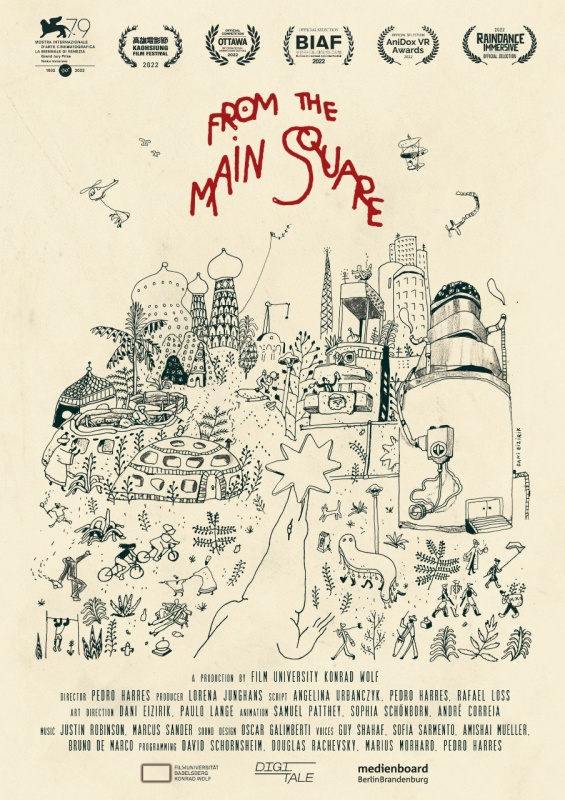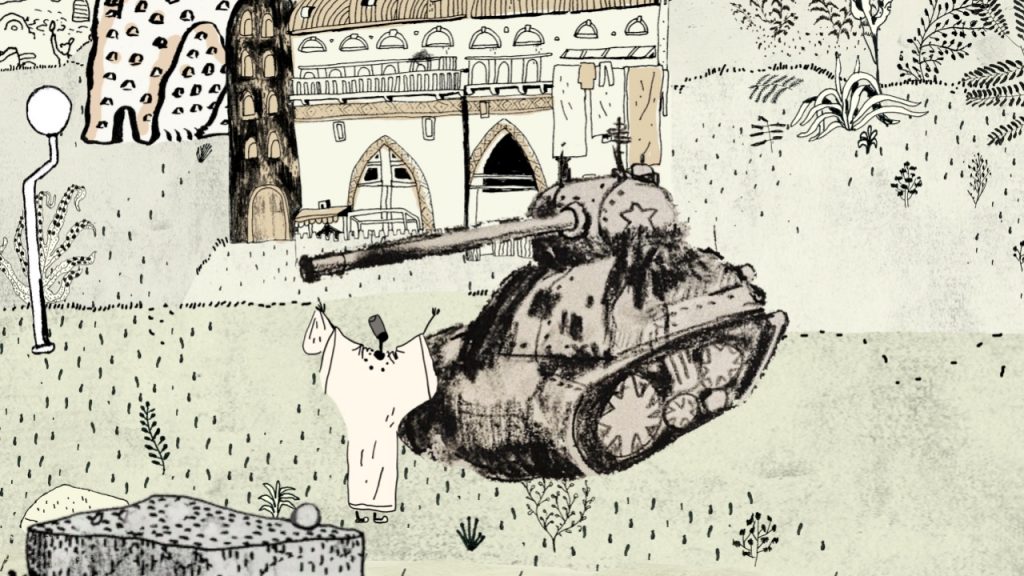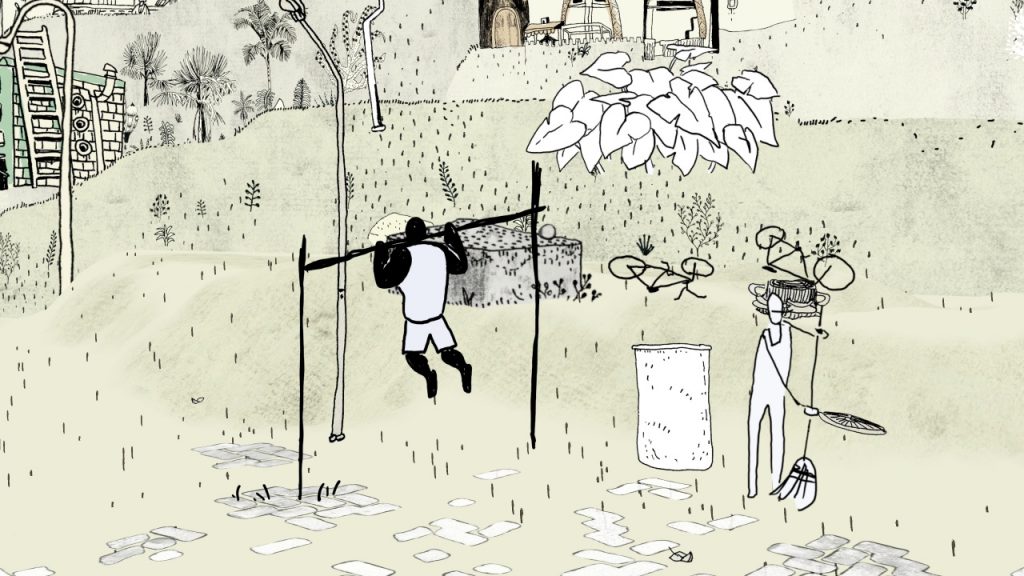Winner of the Venice Immersive Grand Jury Prize, Pedro Harres’ From the Main Square is a surprising (and stunning!) VR debut that combines a clear understanding of immersive storytelling with a story and graphics that leave a mark on the audience.
“From the Main Square is a German production, but I’m a Brazilian filmmaker, I was born and raised in Brazil, and despite being truly happy about being here, there’s something that really breaks my heart. It’s that when I walked through the Palazzo, the Brazilian flag was not there to be seen. And why is that? The reason of that is that there is no Brazilian production here in the program and that happens because in Brazil our government not only is against democracy but also against cinema. And I’d like to ask for how long we, as the film community, will stand aside and look while the most urgent national cinemas are being silenced. Those are the very urgent voices that should be the loudest ones! Can we do it better as a film community, institutionally? I like to end my time here with my favourite sentence in Italian: ‘Siamo tutti anti-fascisti’”
With these words, shared during the awards ceremony of the 79th Venice Film Festival, Pedro Harres received the Venice Immersive Grand Jury Prize for From the Main Square – and left a further mark on our hearts.
The award itself was not surprising: when I experienced this production it was clear to me that this was where we were heading in – juries’ decisions can be hard to understand at times, but some are not, and there are productions that simply need to be formally recognized. From the Main Square was definitely one of them.
What is rather surprising, even now looking back on it, is that From the Main Square is a VR debut produced by a film university (specifically, the Filmuniversität Babelsberg KONRAD WOLF) and created by a school team, about which Harres himself says: “we were quite clueless about how to technically and narratively structure the whole thing. Trial and error was the order of the day” (from the Biennale’s official website).

I have seen works made by extremely experienced teams that are half as good as this one and, what’s worse, have half as much heart. I don’t know if this result stems from the burning passion of youth, which makes you really believe in what you do, or if working with students, possibly young ones, offered perspectives of storytelling that other people might not see, or if “having Berlin before my eyes and Brazil in my mind during the last four years”, as Harres states, made the most difference in the end.
What I know is that From the Main Square is a VR piece you won’t forget and from which we must humbly learn.
First of all it is a work that totally understands storytelling itself and makes it immersive in a never-seen before way: there’s not a single scene happening around you, in this animated drawing, that is useless or not worth to be looked at. Each detail, like the people on the balconies, the dogs barking, the television running in the reservation, the posters – and I could go on mentioning things for hours, literally – is there to take us from this beautiful, almost idyllic landscape to a post-apocalyptic world that resonates with the current times.
I realized, while watching the piece, that I would not have been able to catch everything because, like in those black-and-white hidden-objects games, which are strongly called to mind by the visual style, there’s so much happening at the same time.
But From the Main Square is also a work that has something to tell and does so very clearly, appealing to your emotions in an intelligent but honest way. You smile at some of the scenes, you get worried for some of the creatures involved (flying animals to the zoo, anyone?), you feel regret, you get scared, you cry. Screenwriter Angelina Urbanczyk did an amazing job in this, as did the sound created by Oscar Galimberti and David Schornsheim.
We discussed this work with director Pedro Harres and screenwriter Angelina Urbanczyk, to try to understand how From the Main Square was developed and transformed into an art piece that speaks to the audience and resonates strongly with all of us and the problems in our societies.

On the relationship between art and society
AGNESE – I would like to start from the end: during the Award ceremony you said something very meaningful about Brazil and the role of cinema in our society. Even in your director’s statement, you emphasised the role that Brazil has somehow played in this work. I would like to ask you to comment on this a little more and tell us what it meant to you, a man born and raised in that beautiful but politically difficult country, to bring this work to this festival and see it recognised with this award.
PEDRO HARRES – Although the script was written before he took power, the production of From The Main Square happened within Bolsonaro years. To follow the news of Brazil regularly while focusing on the project in Germany was quite a difficult emotional experience for me. To our dismay, reality was regularly catching up with many brutal moments of our script on a weekly basis. It was very spooky to be honest. It has also showed how violence and its escalation in a society can be somewhat predictable and how art can foresee things.
The vicissitudes of Brazilian society were the main influence on the project, but not the only. We also drew inspiration from other conflicts and societies facing the same type of polarization. The changes in Berlin`s panorama and gentrification were also strong influence for defining the pace of the narrative. We would like the public to experience a familiar but also ever-changing city panorama.
Regarding the award, I felt it was my duty to use this space and exposition to express something about the current situation. Brazilian cinema is under siege by its own government for years. Therefore right after Michel Reilhac, the festival director, called me and informed me that From The Main Square was going to be awarded, I went right into an Italian “cartoleria” in Venice and bought some thick markers and paper… and this happened.

2D animation versus interactive virtual reality
A. – I was honestly amazed by this work. Just thinking about it being a VR debut leaves me speechless, because honestly? I have seen few pieces that understand immersive technologies and immersive storytelling so well. Before we get into the details, may I ask you how From the Main Square came to be?
P. H. – It was originally a short film idea that I had around ten years ago and was adapted to VR shortly before production, during the OmniLab Workshop, ministred by Björn Stockleben at the Babelsberg Film University. The syntax and storytelling method came up from my unsatisfaction with some early 360 animated videos, in which there were only animated characters on a fraction of the space and all the rest would be a dead zone. At the same time, some 360 documentary reports from riots in Sao Paulo with the camera in the middle of the people were incredibly powerful in terms of immersivity and rich in detail. My desire as a director was to produce something that, although animated, could generate an impact similar to Maydan from Sergey Losnitza or Do The Right Thing from Spike Lee, but in an immersive way.
A. – What made VR different from more classical animation, for you? What were the main challenges your team encountered?
P. H. – Well, to be honest, all the steps of a 2D animation pipeline had to be adapted for VR. Storyboarding, Layout, Animation, Sound… everything required a twist. I even wrote a my master thesis about all those adaptations.
But I think that to structure the narrative immersively without any cuts in an entirely non linear fashion in which the player progresses the story by turning around was the most difficult thing. There was simply no other VR-piece in which we could mirror our work. A lot of trial and error had to be carried out before we achieved a storytelling result that was minimally acceptable. For a long time, testing people felt lost and struggled to understand what was it all about. Also the multiple storylines of the script would sometimes convolute themselves in a way that not even I could understand what was going on. I considered giving up and making a 360 video a few times. It was only after we adopted a rigid chapter structure for the organisation of content and we took measures to avoid important things from happening at the edge of the players’ field of vision that things got better.

On the elements that form From the Main Square
A. – Angelina, as screenwriter you did an extraordinary job: everywhere you look there is a scene that moves the story forward. Funny and familiar moments that turn into terribly dramatic scenes. I laughed, I cried, in a couple of moments I kinda ‘screamed’ out loud. How did you develop this immersive, seemingly simple and yet very complex script?
ANGELINA URBANCZYK – Pedro and Rafael Loss had worked on the idea together and Pedro really wanted to go further with it after funding was secured. They had already brought up many situations to become part of the cityscape. I remember the first document I received from Pedro. It was short, but dense: full of notes and pictures based on real cases collected through his research, some first sketches from Dani (a/n Daniel Eizirik, art director of the piece, together with Paulo Lange), too, which I liked a lot. So I said: ‘Yes!’, and we started working literally desk to desk back then in 2018.
What was clear from the beginning on was the differentiation between two groups (we call them Squares and Rounds) as well as working between the languages. The script that turned into a huge collection of storylines was written in German first, but since it is a quite demanding language and the team became more and more multicultural, we decided to translate it to English. Independently from that, text-based development is sometimes not that important in animation. So we had our script, but also numerous thumbnail images from our storyboard being posted and rearranged on a daily basis at the office wall. Hence the whole process can be described as a continuous dialog between those two. What was particular in the context of VR, was the necessity to consider where things would actually happen: each single action had its location set with the help of compass directions, for example.

A. – This work has a very strong visual identity: what prompted you to work in this specific graphic direction and how was it developed?
P. H. – For each project, I normally choose an illustrator whose work and style I consider excellent and seem appropriate for it. Then we adapt it for animation together. The visual identity of From The Main Square is derived from the graphic style of the illustrator Dani Eizirik, one of our art directors. Dani’s style is the fruit of years of research and is very bidimensional. To make it work in a 3D environment was quite a challenge, and required a lot of negotiation. The first prototypes looked quite ugly and he was sometimes skeptical we would ever reach a good visual result. Happily, we got somewhere we are all satisfied with. Dani is the oldest partner that I have on this project, he was storyboarding and making concepts for it way before we ever considered it to be a VR piece. He also made significant late contributions to the script in the layout phase, for which I’m very thankful.
A – Can you tell us some behind-the-scenes stories about the making of From the Main Square and your experience at the Venice Film Festival with the audience?
P. H. – The process of crafting the pseudo languages for the project was very interesting. We developed two languagues: one based on Greek, Bulgarian, Swedish for the Squares; another based on igbo, mongolian, somali, samoan for the Rounds. The process of generating dialog consisted on writing whatever we thought the characters would say on google translate, then translate to all these languages, mash up the results and alter some details. Only 5 voice talents made the voices for all the population. It was very fun to do it but also a challenge for them to make so many characters with different voices.
Not only many scenes were based on real facts, but also many background houses were observational.drawings made in Porto Alegre, Maquiné, Sao Paulo, Brasilia, etc. Even the lizard you see on the experience was spotted in real life, it was just a few centimeters big though.
In Venice we received so many positive feedback that I started recording them and sending as voice messages to a telegram group that I have with the whole crew. The slots were fully booked and people were constantly asking me for VIP ones. I had the feeling that all the effort put in the project was finally paying off in terms of public and this is priceless!

A. – What are your plans regarding the distribution of From the Main Square?
P. H. – Well, our general plan is to do festivals, then galleries/events and finally publish the project on a gaming platform like Steam. I also want to make a non immersive short film version of it so that more people can see it. Especially in Brazil, VR headsets are still a rare thing. This is our first VR-piece, so we are still sorting that out.
From the Main Square is a work by Pedro Harres produced by the Filmuniversität Babelsberg KONRAD WOLF. Find out more about it on Pedro Harres’ official website.



Leave a Reply
You must be logged in to post a comment.